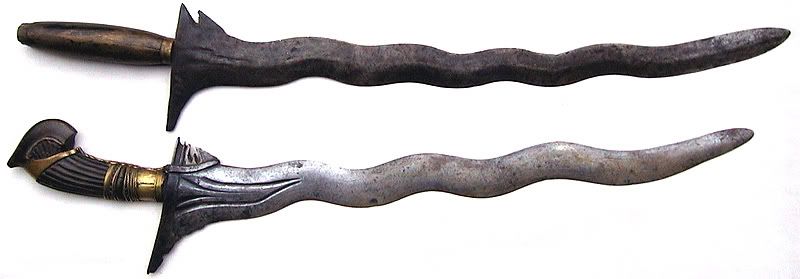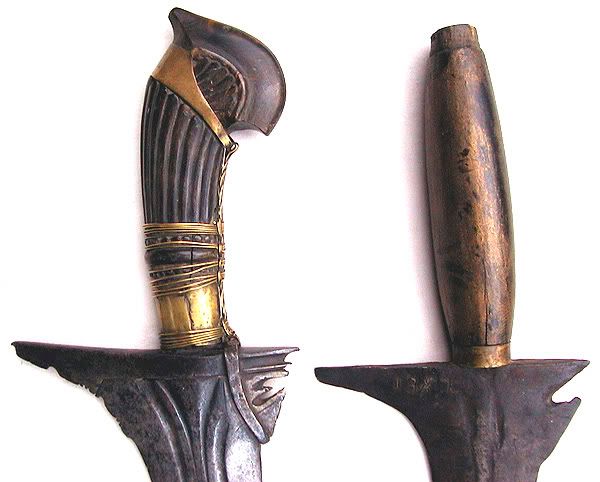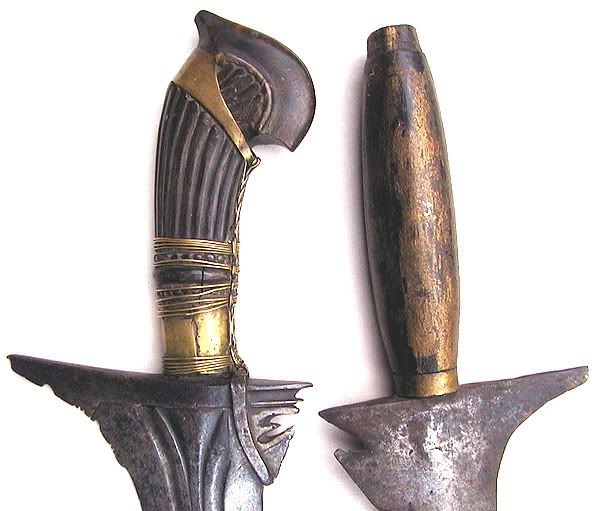
 |
|
|
|
|
#1 |
|
Member
Join Date: Dec 2004
Location: Houston, TX, USA
Posts: 1,254
|
One of those blades where it's hard to tell crudity from corrosion, at least in a photo. The grooves have a forged in look? There does not look to be a seperate gonjo, and if there ever was one it must have been a straight joining, which is not usually seen on Moro pieces, but then if it's a particularly old piece......could that be a Moslem date?
|
|
|

|
|
|
#2 |
|
Member
Join Date: Mar 2005
Posts: 306
|
Hi all!
If that is a muslim year it translates to 1961. Hopefully this chould help with a date. |
|
|

|
|
|
#3 |
|
Vikingsword Staff
Join Date: Dec 2004
Location: The Aussie Bush
Posts: 4,396
|
Rick:
It is mine -- a recent acquisition off eBay. I will add dimensions later tonight. Here are some more pictures showing a side-by-side comparison with a more traditional old Moro kris (late 18th or early 19th C.). Ian. EDIT: Here are the dimensions of these two swords. Top one (Mystery Kris) OAL = 22.75 inches Blade = 18 inches Width of gangya = 3.75 inches Thickness of blade just below handle = 3/8 inch Bottom one (Old Moro Kris) OAL = 21.75 inches Blade = 17.25 inches Width of gangya = 4 inches Thickness of blade just below handle = 1/2 inch Old Moro Kris with Spanish Hilt (2)    Last edited by Ian; 24th May 2005 at 01:59 PM. Reason: Dimensions addd for the two swords |
|
|

|
|
|
#4 |
|
Vikingsword Staff
Join Date: Nov 2004
Posts: 6,339
|
IMO , when viewed next to that old beauty it only serves to accentuate its alieness .
Of course smiths come in all different skill levels but still it just doesn't look look 'native' to me . A very interesting piece . |
|
|

|
|
|
#5 |
|
Member
Join Date: Dec 2004
Location: Minneapolis, MN, USA
Posts: 312
|
The number could always be an accession number (hmmm...is that the right term?). Ive seen some museums do horrible things to blades they accept (well this is not something that all museums do, but well some have). Anyways, agree with Rick, there is something odd about this kris/keris, something that goes beyond just mere corrosion. It would seem that all we really have to ID this kris would be the dapur, and even given more we've had plenty of argument over the older style kris. Especially given the lack of other features (particularly no fretwork, no detail around the trunk, no detail around where the arrowhead could be if it is an arrowhead, etc...), at least for me, it would be hard to peg this kris/keris one way or the other.
|
|
|

|
|
|
#6 |
|
Member
Join Date: Dec 2004
Location: Cincinnati, OH
Posts: 940
|
I once again submit the Aliens Theory.

|
|
|

|
|
|
#7 |
|
Vikingsword Staff
Join Date: Dec 2004
Location: The Aussie Bush
Posts: 4,396
|
When I put this one next to the other old Moro kris in the pictures above, it seemed to me that the gangya may actually be complete. So I polished the reverse side in the gangya area to remove some of the heavy patina. For a short distance I can identify a horizontal line meeting a section of an angled line where the gangya separation should be. It is very faint and only visible with a magnifying glass. I believe the gangya is actually intact and not missing its top half as I stated earlier. This is consistent with Moro work where the line of separation can be very hard to distinguish sometimes.
Acknowledging opinions above to the contrary, I believe this blade is just too well forged and the luks too symmetrical around the median ridge for it not to have been made in its host culture. This has not been forged by an alien group in the image of a Moro kris. What I think is throwing people off is the file work (or lack thereof), the extensive corrosion of the gangya area, and the likelihood that the gangya was modified by another hand. The "trunk" area, in particular, appears to have been filed down and altered. Rick: I can't find my calipers to measure the thickness of the blade. Will get back to you when I locate them. Ian. |
|
|

|
|
|
#8 | |
|
Vikingsword Staff
Join Date: Nov 2004
Posts: 6,339
|
Quote:
Okay , watch me flip flop .  That throws out the possibility of a foreign trade piece (at least for me) . Now the question is why would someone alter the trunk area ? Could this sword have been excavated a long time ago and corrosion had done the damage . Maybe this is an unfinished work as has been mentioned earlier , but I'm doubting that . Note the graceful curve of the gangya top on the old , complete kris . Now note the absolutely straight one on the mystery example. We have seen other examples IIRC some years ago there was a kris with an uncarved , blank trunk area ; anyone else remember this one ? Federico , was that Jimmy's kris ? I've got to disagree with you Tom ; I know everything is in the eye of the beholder but the mystery kris just appears downright clumsy in its execution compared to the other one . How about a blade length and width Ian ? |
|
|
|

|
|
|
#9 |
|
(deceased)
Join Date: Dec 2004
Location: OKLAHOMA, USA
Posts: 3,138
|
THE BLADE MAY SIMPLY BE UNFINISHED, SOMETIMES A BLADE IS PUSHED INTO USE BEFORE THE FINISHING WORK CAN BE DONE. THIS COULD HAPPEN DUE TO A DIRE NEED FOR WEAPONS AS FAST AS POSSIBLE OR PERHAPS A CHEAPER MODEL OR THE FORGE COULD HAVE FALLEN INTO ENEMY HANDS, SO FINISHED AND UNFINISHED GOODS WERE TAKEN AND MODIFIED FOR USE.
MANTERIS HAS A MORO KRIS THAT APPEARS SOMEWHAT UNFINISHED AS IT DOSENT HAVE THE CUT OUT WORK DONE ON THE GAGAH OR GRENENG. I HAVE A INDONESIAN KERIS BLADE THAT I THINK IS THE CORE WITHOUT THE PARMOR SANDWICHED ON BOTH SIDES SO IT DOES HAPPEN. 
|
|
|

|
|
|
#10 |
|
Member
Join Date: Dec 2004
Location: Houston, TX, USA
Posts: 1,254
|
And here I am struck by the SIMILARITY between the two swords. Especially the taper, the curvature, and the unusual length/broadness of the luks, as well as the similarity in the overall shape of the cutout at the front of the blade base, which is on both different than on other (newer) kris sundang. I don't know whether there is any crudity at all; there is a rough and cloudy appearance, which judging from photos and further info. could easily be entirely from rust/wear. The way the two grooves are deep and seem to "trail out" into skinny ones is consistent with what we see on the other. Note that connecting the bacca/asang all the way back to a loop (positive machanical hold) around the pommel seems to maybe be the original way.
I feel that an European official of any sort from the mid 1800s on would be much more likely to use European style number stamps if he were to do a thing like number the blade? The skill in making the numbers does not seem great. This lack of skill could be for the chiselling, but it could alternatively be for writing them. I have a Javanese sword that seems to have "1940" inlaid in its blade in brass. The reason I keep saying "seems to" is that the numerals are of various sizes and nonstandard forming, and could be an unfamiliar writing making a coincidence. |
|
|

|
 |
|
|